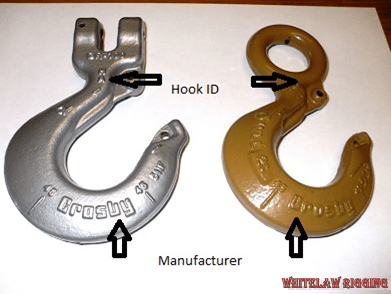
How to Find the Right Hook Latch

Hook latches are designed to help keep rigging and attachments in the hook, under slack conditions. Hook latches are not designed nor intended to support the load. I mention this because the term “safety latch” is often used when talking about hook latches, but in most cases, suppliers will use the terms “hook latch” or “replacement latch kit.”
That being said, finding the proper replacement latch for your hook can be tricky. Latches from other manufacturers will not fit your hook properly. Manufacturers have changed hook profile patterns over time – so an old latch will not fit a new hook and vice versa.
In many cases hooks that serve different purposes will have different latches, though the hooks have similar dimensions.
So the bits of information useful in identifying a latch would be:
- What type of hook is it, by use?
- What company manufactured the hook?
- What is the hook size?
- What is the hook age?
This posting will attempt to help you visually identify these bits of information. First let’s look at common hook types.
Hook Types
A brief description of hook types referenced by number.
- Clevis sling hook. This hook has a clevis for direct attachment to chain.
- Eye grab hook with latch. Must be attached to chain with a coupling link.
- Clevis grab hook with latch. Has clevis for direct attachment to chain.
- Rigging hook or eye hook. Has a large eye typically for use with wire rope or synthetics. Eye is large enough to allow for thimble.
- Web sling hook. Used with web slings or round slings. Wide eye allows for distribution of web.
- Swivel hook. Typically used with wire rope or synthetics. Can be used with chain under certain circumstances. Not designed to swivel under load.
- Sliding choker hook. Used with wire rope.
- Hoist hook with Bullard latch. Used with manual, air or electric chain hoists. Also referred to as a chain nest hook.
- Hoist hook with standard latch. Used with manual, air or electric chain hoists. Also referred to as a chain nest hook.
Hook Manufacturer and Size
Having identified the type of hook, let’s move on the next items, hook manufacturer and size.
Quality manufacturers mark their hooks for identification. Look for these trademarks:

The Crosby Group©: Look for raised embossed “Crosby” on the lower part of the bowl of the hook. Typical Crosby colors are Platinum for grade 100 alloy, gold for grade 80 alloy and red for carbon steel. Crosby provides a Hook ID that can be used to identify the replacement latch kit size. The Hook ID is located near the clevis or eye.

Gunnebo©: Look for raised embossed “Gunnebo” on the lower part of the bowl of the hook. Typical Gunnebo colors are yellow and high visibility yellow-green. The type of hook, size in mm and grade of alloy is embossed near the side of the bowl.

Pewag©: Look for raised embossed “Pewag” on the lower part of the bowl of the hook. Typical colors are safety orange for grade 100 alloy (Winner), blue for grade 120 alloy (WinnerPro). The hook style and size in mm is located near the bottom of the bowl. Pewag also markets an ELD line of eye hooks and swivel hooks as shown in the right part of the picture. Look for “ELD” mark mid-way up the bowl of the hook. ELD colors are blue for carbon and red for grade 80 alloy.

Acco©: A brand of Peerless Industrial Group, look for “Accoloy” near the bottom of the hook bowl. The size will be near the eye or clevis of the hook, with the size in inches on one side and the size in mm on the other size. Acco color is red. The picture shows an eye sling hook. This is different from the rigging hook as the eye is designed for a chain coupler.

CMCO Columbus McKinnon: Look for raised embossed “CM” near the eye or clevis of the hook. HA 800 or HA 800/1000 on the side of the hook to indicate alloy grade compatibility. The size is embossed near the bottom. Color is safety orange.

Laclede©: Laclede markets Cartec chain hooks. Look for raised “Cartec” embossed near the bottom of the hook bowl. The chain size is also indicated near the bottom of the hook. Cartec color is orange or red.
Hook Age
For the last identification item, let’s consider the age of the hook. Starting in the 1990s many manufacturers realized they could improve their products by changing the hook pattern at the tip of the hook. This improvement involved creating a profile at the tip that would allow a notched latch to interlock with the tip of the hook. You will see this profile in the above pictures of Crosby, Gunnebo, CM and Laclede (Cartec) hooks. Naturally, an old style latch will not fit the new style hook profile.
To expedite your search, include the following in the search box: hook type, manufacturer, and size. For example “Crosby, clevis sling hook, 9/32”. You may get a return of both old style and new style latches to select from.
We realize this does not cover all of the possible variations of hook latches available, but we have attempted to cover the major types commonly in use. If all else fails, send us a picture with a ruler or tape measure in the picture for scale. We’ll do our best to identify the latch.

